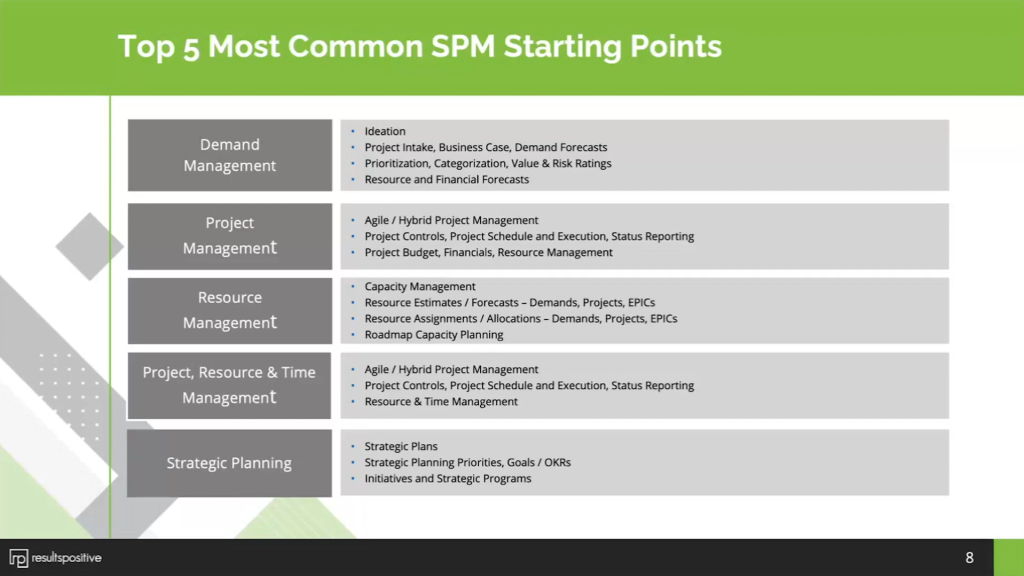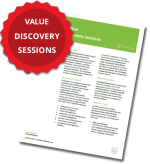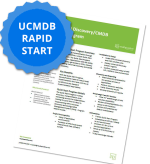ServiceNow SPM: Top 5 Most Common Starting Points
Are you new to ServiceNow SPM or struggling to maximize its potential? You’re not alone—many IT managers, project managers, and portfolio managers face the challenge of knowing where to begin. ServiceNow Strategic Portfolio Management (SPM) is a powerful tool designed to align projects, resources, and strategies with business goals. However, diving in without a clear plan can feel daunting.
In this blog post, we’ll explore the top five most common starting points for implementing or optimizing ServiceNow SPM. These starting points—Demand Management, Project Management, Resource Management, Project/Resource/Time Management, and Strategic Planning—offer a practical foundation for success. Whether you’re just embarking on your SPM journey or seeking to enhance your current setup, these insights will help you unlock the full potential of ServiceNow SPM. Let’s dive into these key areas and discover actionable steps to get started.

1. Demand Management
Demand management is often the first step in building a successful SPM framework. It’s the process of capturing, evaluating, and prioritizing project ideas and requests within ServiceNow SPM. Imagine it as the front door to your project portfolio—a place where ideas are collected, reviewed, and either approved or deferred based on their potential impact.
Key Elements of Demand Management
-
Ideation: SPM provides a centralized platform for teams and stakeholders to submit creative ideas, ensuring nothing valuable gets overlooked.
-
Project Intake & Business Case: Ideas transform into formal project requests, complete with a business case that outlines their purpose and value.
-
Prioritization & Categorization: With SPM, you can rank requests based on criteria like strategic fit, risk, and expected benefits.
-
Resource and Financial Forecasts: Before greenlighting a demand, SPM’s tools help you assess whether your team and budget can support it.
Why It Matters
Demand management acts as a filter, ensuring that only the most impactful projects move forward. It prevents resource waste on low-priority initiatives and keeps your portfolio aligned with organizational objectives.
Practical Tip
Kick things off by designing a simple intake form in SPM to gather project requests. Include fields for the project’s purpose, anticipated outcomes, and resource requirements. Once you’ve collected a handful of submissions, use SPM’s prioritization tools to rank them according to your business goals. This straightforward approach sets a solid starting point for ServiceNow SPM.
2. Project Management
Once your demands are approved, they evolve into projects—and that’s where project management in ServiceNow SPM shines. This component provides a structured framework for planning, executing, and tracking projects from inception to completion. It’s the engine that drives your initiatives forward.
Key Elements of Project Management
-
Agile/Hybrid Approaches: SPM accommodates both traditional and agile methodologies, offering flexibility to suit your project’s needs.
-
Project Controls & Scheduling: Tools for managing timelines, milestones, and deliverables keep everything on course.
-
Status Reporting: Real-time dashboards and updates offer visibility into project health, helping you catch issues early.
-
Budget & Resource Management: Integrated features allow you to monitor costs and allocate resources effectively.
Why It Matters
Strong project management ensures that your initiatives are delivered on time, within scope, and with the desired results. It promotes accountability and keeps stakeholders in the loop, fostering confidence in your team’s ability to deliver.
Practical Tip
Take advantage of SPM’s project dashboards as a starting point. Customize them to display critical metrics like progress, budget usage, and resource allocation. This gives you an at-a-glance view of your projects, making it easier to manage them effectively within ServiceNow SPM.
3. Resource Management
Even the best-laid project plans can stumble without proper resources. Resource management in ServiceNow SPM focuses on optimizing your team’s capacity and ensuring that the right people are assigned to the right tasks at the right time. It’s about working smarter, not harder.
Key Elements of Resource Management
-
Capacity Management: Balance workloads to avoid burnout and confirm your team can handle upcoming projects.
-
Resource Estimates/Forecasts: Plan ahead by predicting resource needs for projects and other demands.
-
Assignments/Allocations: Match team members’ skills to tasks for maximum efficiency and quality.
-
Roadmap Capacity Planning: Align resource availability with long-term project plans to prevent overcommitment.
Why It Matters
Effective resource management boosts productivity and ensures project success. Without it, teams can become stretched thin, leading to delays and subpar outcomes.
Practical Tip
Start by generating capacity reports in SPM to pinpoint bottlenecks or underutilized areas. These reports reveal where adjustments are needed, helping you allocate resources wisely and establish a key ServiceNow SPM starting point.
4. Project, Resource & Time Management
While project and resource management are vital individually, combining them with time management creates a seamless, integrated approach. In ServiceNow SPM, this unified view lets you oversee schedules, resources, and time tracking within a single platform, streamlining your processes.
Key Elements of Integrated Management
-
Unified Tracking: Monitor project progress, resource use, and time spent on tasks without jumping between tools.
-
Agile/Hybrid Support: SPM adapts to your preferred methodology—agile, waterfall, or hybrid—ensuring alignment with your workflow.
-
Status & Resource Insights: Get a holistic view of how time and resources are utilized, enabling timely adjustments.
Why It Matters
This integrated approach breaks down silos and enhances efficiency. It ensures that schedules, resources, and effort are synchronized, driving better project outcomes.
Practical Tip
Use SPM’s time tracking features as a starting point to align your team’s effort with project priorities. By monitoring time spent on tasks, you can spot misallocations early and refine your approach, making this a critical ServiceNow SPM starting point.
5. Strategic Planning
Strategic planning ties everything together and is perhaps the most essential starting point in ServiceNow SPM. It’s about aligning your projects and resources with your organization’s long-term vision. Without it, even well-executed projects may fail to deliver meaningful value.
Key Elements of Strategic Planning
-
Strategic Plans: Define a clear direction for your portfolio, ensuring every project supports the overarching mission.
-
Priorities & Goals/OKRs: Set measurable Objectives and Key Results (OKRs) to guide progress and focus efforts.
-
Initiatives & Programs: Manage large-scale efforts that span multiple projects, keeping them cohesive and purposeful.
Why It Matters
Strategic planning guarantees that your portfolio drives real business impact. It shifts the focus from busywork to initiatives that matter, aligning every effort with the bigger picture.
Practical Tip
Begin by defining a few key OKRs in SPM that reflect your organization’s priorities. These will act as a compass for your portfolio, ensuring that every project contributes to your strategic goals—a foundational ServiceNow SPM starting point.
Let’s Get Started
Getting started with ServiceNow SPM doesn’t have to be intimidating. By focusing on these five key starting points—Demand Management, Project Management, Resource Management, Project/Resource/Time Management, and Strategic Planning—you can lay a strong groundwork for success. Each area plays a pivotal role in aligning your projects with business goals, optimizing resources, and delivering results efficiently.
If you’re new to SPM, resist the urge to tackle everything at once. Start with one or two of these starting points and build from there. For instance, you might begin with Demand Management to prioritize the right projects, then transition to Resource Management to fine-tune your team’s capacity. This incremental approach builds confidence and competence over time.
To support your journey, feel free to watch our ServiceNow SPM Implementation webinar with step-by-step instructions and best practices for each of these starting points.
The secret to success with ServiceNow SPM lies in starting with a clear plan and growing steadily. By leveraging these ServiceNow SPM Starting Points, you’ll be well-equipped to harness the full power of your project portfolio and drive meaningful outcomes for your organization.
Don’t miss our latest ServiceNow SPM plugins for creating and presenting Strategic Plans, and our latest Project Portfolio Portal for dynamic dashboards and real-time analytics.










